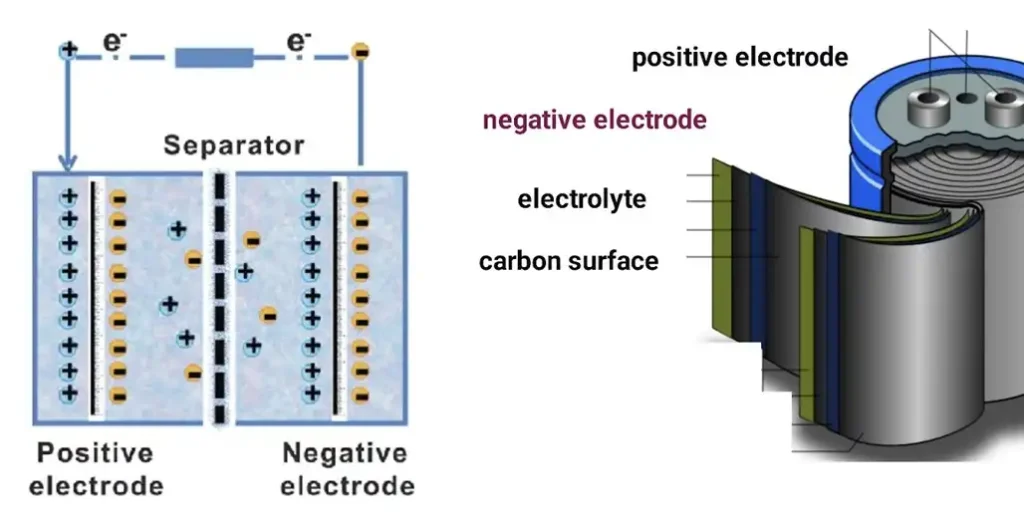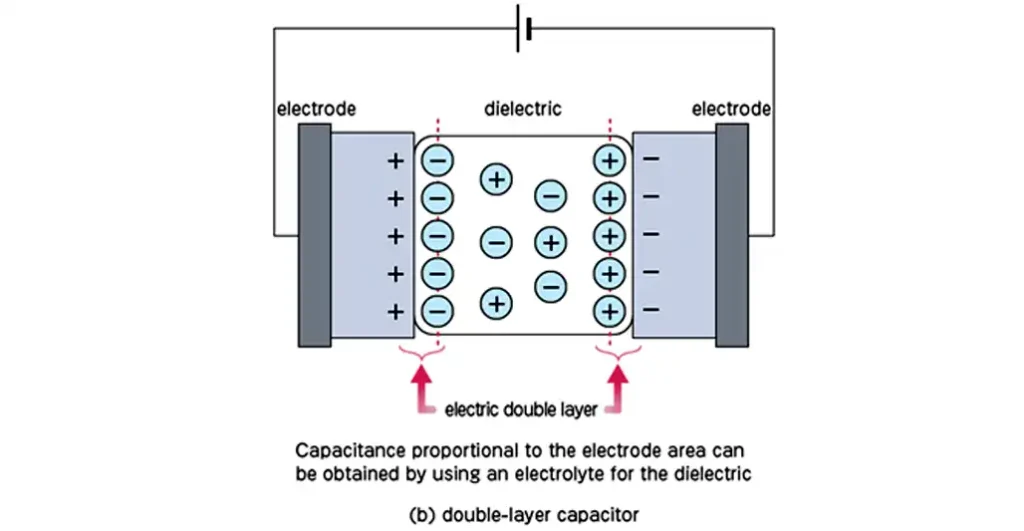In today’s fast-paced and energy-driven world, finding efficient and reliable energy storage solutions is more vital than ever. One such solution that has gained significant attention in recent years is the Electric Double Layer Capacitor (EDLC), also known as a supercapacitor.
Offering remarkable performance and benefits, the EDLC stands out as a promising alternative to traditional battery technologies. Join us as we delve into the fascinating world of EDLCs and explore their incredible potential.
What Is Electric Double Layer Capacitor

An Electric Double Layer Capacitor is an energy storage device that utilizes the phenomenon of electrostatic double-layer formation to store electric charge. Unlike traditional batteries that store energy through chemical reactions, EDLCs store energy electrostatically, resulting in some unique advantages.
The Structure:
EDLCs consist of two electrodes, separated by an electrolyte and a conductive polymer separator. The electrodes are typically made of activated carbon with an incredibly high surface area, enabling a larger capacity to store charge. This large surface area allows for the creation of a double layer of ions at the electrode-electrolyte interface, giving the EDLC its name.
Impressive Energy and Power Density:
One of the key advantages of EDLCs is their ability to deliver both high energy and power densities. While batteries typically offer high energy densities but low power densities, and capacitors exhibit high power densities but low energy densities, EDLCs bridge this gap by combining the best of both worlds. This unique attribute makes them particularly suitable for applications requiring rapid energy bursts and quick charge/discharge cycles.
Rapid Charge and Discharge:
Unlike batteries that require hours to charge, EDLCs can be charged in a matter of seconds or minutes. This rapid charge and discharge capability make them ideal for regenerative braking systems in electric vehicles, where capturing and releasing energy efficiently is crucial. Moreover, the extended cycle life of EDLCs, ranging from hundreds of thousands to over a million cycles, ensures their longevity and reliability.
Enhancing Energy Efficiency:
Alongside their rapid response times, the EDLCs offer exceptional energy efficiency. They have low internal resistance, enabling them to deliver charge and absorb energy quickly without significant losses. This efficiency makes them a valuable component in energy management systems, grid stabilization, and renewable energy applications.
Electric Double Layer Capacitor Principle

The principle behind an Electric Double Layer Capacitor (EDLC) lies in the formation of an electrostatic double layer at the interface between the electrode and electrolyte. This double layer stores electrical charge without involving any chemical reactions, distinguishing EDLCs from traditional batteries.
Unlike regular capacitors, which typically consist of two conductive plates separated by a dielectric material, EDLCs use porous electrodes with a high surface area. The most common electrode material is activated carbon, chosen for its extensive surface area per unit volume.
When an electric potential is applied across the EDLC, a process called “double layer formation” occurs. The electrode-electrolyte interface behaves in a unique way due to the high surface area of the electrodes and the presence of charged species (ions) in the electrolyte.
The double layer consists of two layers: the inner layer, known as the electrical double layer, and the outer layer, known as the Helmholtz layer. The electrical double layer consists of adsorbed ions on the electrode surface, while the Helmholtz layer consists of solvent molecules and ion clouds surrounding the adsorbed ions.
As a voltage source charges the EDLC, positive and negative ions from the electrolyte are attracted to the opposite electrodes. The cations (positive ions) are adsorbed onto the negatively charged electrode, and the anions (negative ions) are adsorbed onto the positively charged electrode. This segregation of charges creates a voltage potential across the electrodes, allowing electrical energy to be stored.
The capacitance of an EDLC is determined by several factors, including the surface area of the electrodes, the distance between the electrodes, and the properties of the electrolyte. The high surface area of the porous electrodes is essential because it allows for more ions to be adsorbed, increasing the amount of stored charge.
During discharge, the stored energy is released as the ions move back into the electrolyte, returning to their original state. This process is highly reversible, which allows for numerous charge/discharge cycles without a significant degradation of the EDLC’s performance.
By harnessing the principles of the electric double layer, EDLCs offer unique advantages such as high energy and power density, rapid charge/discharge capabilities, and long cycle life. These qualities make them well-suited for various applications, ranging from electric vehicles and renewable energy systems to portable electronics and industrial power management.
Applications of Electric Double Layer Capacitor
Electric double layer capacitors (EDLCs), also known as supercapacitors or ultracapacitors, have various applications across different industries due to their unique characteristics. Here are some key applications of electric double layer capacitors:
Energy storage: EDLCs are widely used for energy storage applications. They can store and rapidly release large amounts of electrical energy, making them suitable for applications where high power density and fast energy transfer are required. EDLCs can be used as an alternative or in conjunction with batteries, providing quick bursts of energy for devices like hybrid vehicles, electric bikes, and tools.
Backup power systems: EDLCs are used in backup power systems to ensure uninterrupted power supply during power outages or to provide temporary power during maintenance or switching operations. They can act as a bridge between the loss of primary power and the activation of standby power sources, ensuring a smooth transition and preventing downtime.
Regenerative braking systems: EDLCs are employed in regenerative braking systems used in electric and hybrid vehicles. When the vehicle brakes, the kinetic energy is converted into electrical energy and stored in the EDLCs. This energy can then be used to power the vehicle, reducing energy wastage and improving overall efficiency.
Renewable energy integration: EDLCs are used in conjunction with renewable energy sources like solar or wind power. They help smooth out the intermittent and fluctuating energy output of these sources, stabilizing the power supply and improving grid performance. EDLCs can store excess energy generated during high output periods and release it during low output periods, ensuring a more reliable and consistent power supply.
Peak power shaving: EDLCs can be used to manage peak power demands in various applications, such as in industrial or commercial settings. By discharging stored energy during periods of high power demand, EDLCs alleviate the strain on the electrical grid, reduce the need for additional power generation capacity, and help avoid costly peak demand charges.
Consumer electronics: EDLCs find applications in portable electronic devices, such as smartphones, laptops, and cameras. They can be used to provide quick bursts of power needed for high-performance tasks or to extend the battery life by offloading some power-demanding functions to the EDLC.
Energy harvesting: EDLCs can be paired with energy harvesting systems that capture and store energy from ambient sources like light, heat, or vibrations. These systems can power low-energy devices such as wireless sensors, IoT devices, or medical implants, eliminating the need for batteries and enabling maintenance-free operation.
Uninterruptible power supplies (UPS): EDLCs are used in UPS systems to provide short-term power during switching between primary and backup power sources. They ensure a seamless transition during power outages or fluctuations, preventing data loss, equipment damage, and system downtime.
These are just a few examples of the wide range of applications for electric double layer capacitors. As technology continues to advance, EDLCs are likely to find even more applications in various industries and contribute to the development of more efficient and sustainable energy storage solutions.
Conclusion
As the demand for efficient, sustainable, and reliable energy storage solutions continues to rise, the Electric Double Layer Capacitor emerges as a powerful contender. Its unique properties, such as high energy and power density, rapid charge/discharge cycles, and exceptional efficiency, position it as a technology with huge potential. By powering electric vehicles, integrating renewable energy, bolstering portable electronics, and aiding various industrial sectors, EDLCs are shaping a more sustainable and promising future. They serve as a remarkable example of how innovation in energy storage can revolutionize multiple industries while reducing our carbon footprint.




















